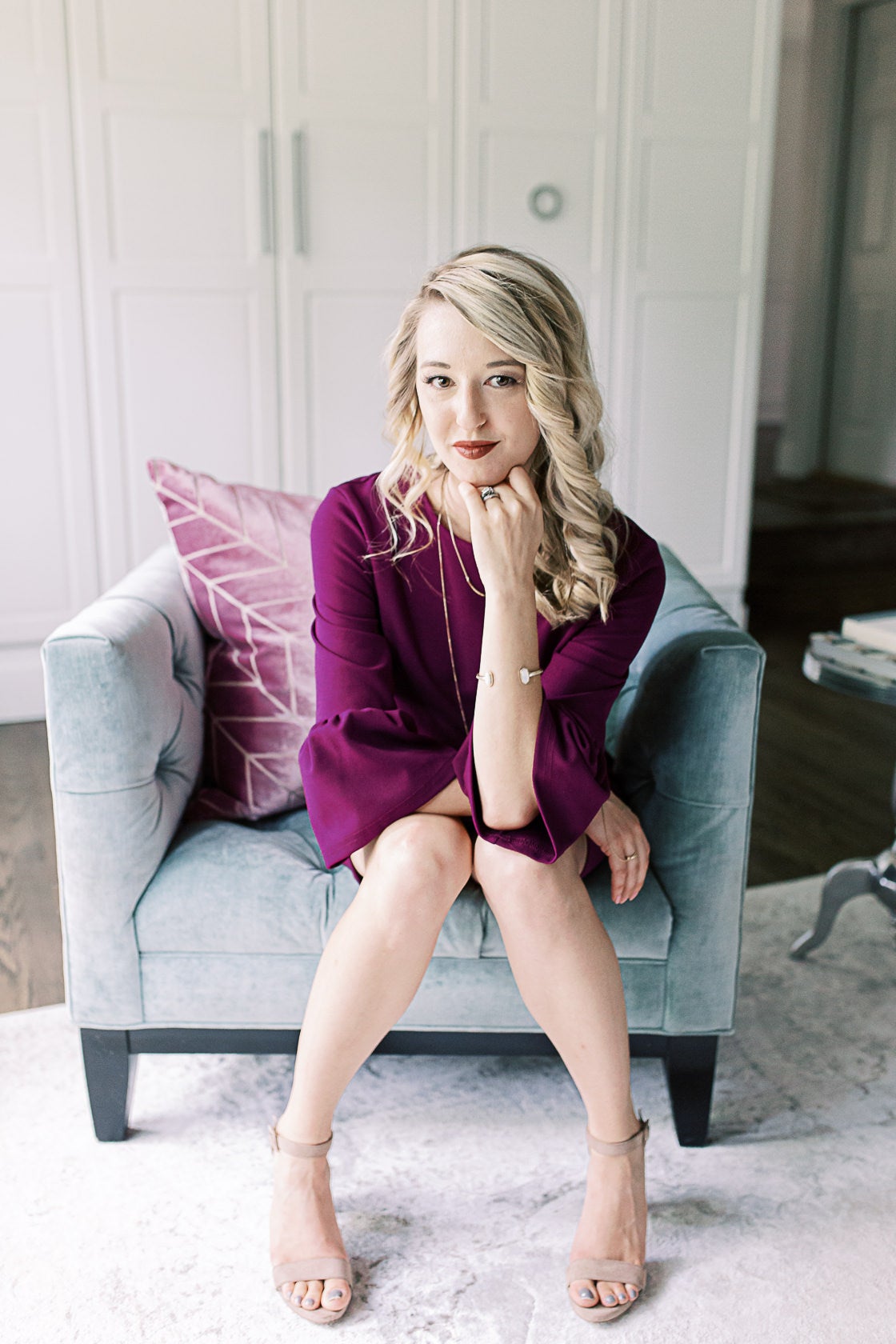The 50 States Project is a yearlong series of candid conversations with interior designers we admire, state by state. Today, we’re chatting with Courtney Otte of Omaha, Nebraska–based Modern Hive Interior Design Studio about why investing in systems has been worth it, how renderings help her sell her vision, and why she’ll never outgrow one-room projects.
You’ve spent your entire career in Omaha. Can you tell me about the design scene there?
Omaha is a great location to be an interior designer right now. It seems like people have really steady jobs here—there are corporations that have founded their home bases in Omaha, so there’s a lot of opportunity to work with clients who have resources and funds available to make really amazing spaces.
As far as an aesthetic, the city has gotten a lot more [up to speed] with current trends in the past five years, but it seems like we are usually just a little bit behind. With social media and Pinterest, designers here—and clients—now [have] those things at their fingertips, and I think it allows us to catapult into the current trends.
Is that something you’ve seen change over the course of running your firm?
Oh, for sure. I started my firm in 2012, just as people were starting to really use Pinterest. I actually planned my wedding in 2012, and it was the same kind of thing: I would hop on there occasionally to get ideas, but I didn’t solely rely on it to come up with these ideas, and I’m sure clients around that time felt the same way. Now, that’s one of my go-tos for inspiration, and when I’m onboarding new clients and I have them do client homework, part of that process is to go on Pinterest.
How do you set them loose in Pinterest—are you helping them figure out what to search for?
They’re mostly on their own, but I do provide them with a PDF where I’ve outlined about 20 different design styles, because sometimes people really don’t know. The document, which is based on a blog post I wrote, basically just says: “If you’re not sure what your style is, or if you’re really confused with the different styles out there ... ” And I gave a couple different images of each style with bullet points on the main features of each one. I think that helps them.
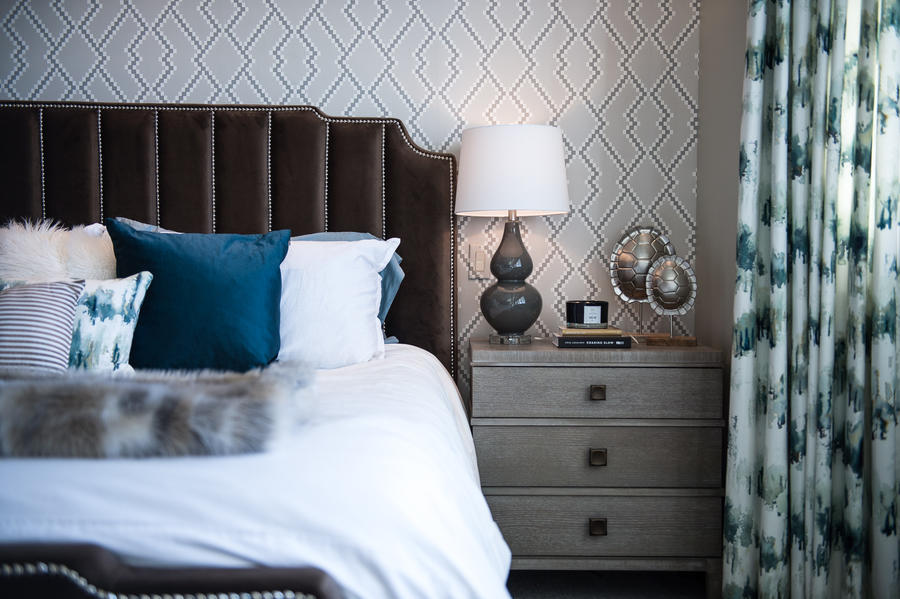
Totally. How do your clients find you?
A lot of them find me on Google and Instagram. I’ve noticed a trend that I work with a lot of entrepreneurs—which is really exciting and fun, since I am an entrepreneur myself. It seems like they get it: They understand the process and how hard you have to work to get somewhere, and it’s just really fun to collaborate with that kind of person.
And then, once they’ve reached out, what does that initial conversation look like?
I’m notorious for not answering my phone if I don’t recognize the number—I just get a lot of fluff phone calls that just want to pursue me for advertising. But in my voicemail, it says that if you’re a new client, hop on my website, click on our contact page, and there’s a client intake form with a few simple questions. I use a [customer relationship management (CRM)] system for that called Dubsado, which sends an email notification that I’ve got a new lead; once I’ve reviewed it, I’ve got a system set up where I send a form email that either says, “You sound like a great fit. I’d love to discuss our service offerings with you. Here’s a link to schedule a call with me,” or there’s an email that goes out that says basically the opposite but in a nice way.
When did you realize that you needed to really qualify those leads in that way—and to turn down some projects?
Turning down projects is so hard, I still struggle with it. But it was when I started using a CRM system about two years ago—I actually worked with a specialist. She’s essentially a business coach who helps entrepreneurs set up workflows. She helped me set up my CRM system and that was part of the process: How do you want to manage leads? We created a ton of canned emails, and that’s pretty much how I got started.
How did you find her, and what was the process of working through that?
Dubsado has a Facebook group for people who use their system, and I had posted that I was looking for someone to help me set it up. It’s really overwhelming; I didn’t have time or even know where to start. I got a ton of messages; she commented on the thread, and when I checked her stuff out, [her work] clicked really well with me. It actually took almost a year to fully get the system set up. She assigned so much homework to me, and it took forever, but it was well worth it.
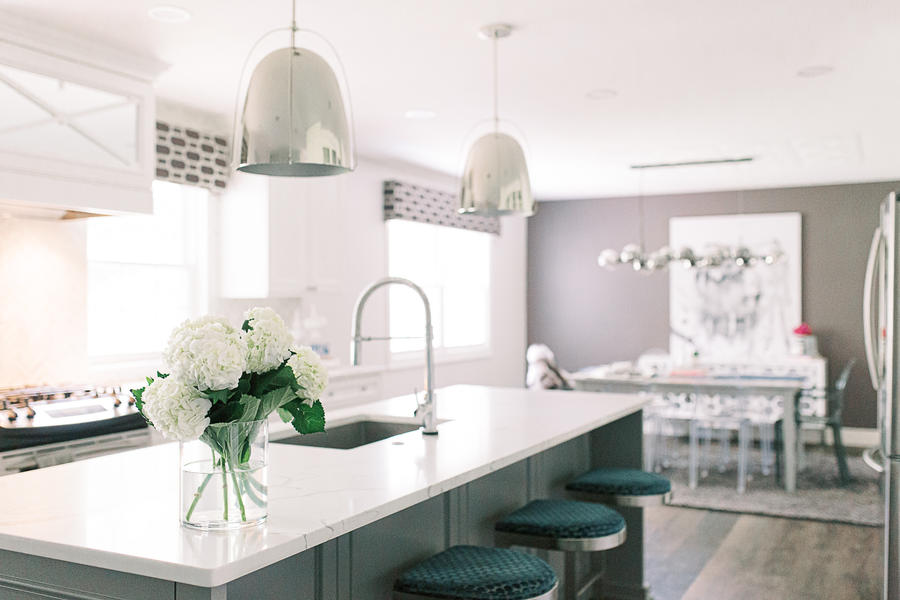
I love that you give client homework, and then you got client homework.
I know, so I understand their pain and struggle!
What was the homework?
We did a lot of Zoom calls. She asked me to describe my services—she was setting up Dubsado, but I also wanted her to set up systems for all of these different service offerings that I have. That way, when the time comes to bring on another designer on my team, I can just be like, “Here is the workflow of how this project should run. Run with it—it’s integrated into Dubsado, and it’s also on ClickUp, which is an Asana-like platform, so it should be pretty seamless.”
So our calls would start off with a casual conversation, me explaining the service to her; she would take detailed notes, then come up with a mapped flow. She would identify different project points when communication would need to go out through Dubsado’s CRM system to keep the client engaged. Design takes a long time, and sometimes there are points where we’re not really talking to our clients for a long time—and you know, when they’re spending a lot of money with us, that can be kind of nerve-wracking if they don’t hear from us for two months! So we set up different emails throughout the project.
You said part of the idea was that if you brought another designer on, your systems would be ready to go. Was that the real impetus to pursue this in the first place?
About three years ago, I realized it is important to have systems in place. If it’s just me who has all the knowledge, then do I have a business or a hobby? You know? What happens if I can’t do the work for some reason? I think that partially came from the power of social media. I’m in a lot of different Facebook groups for designers, and that is one of the biggest things that people are hitting on these days: You need to have a system set up. I played around with it for about a year, trying to map out my own systems, and I was like, “I really just don’t have time for this.” I needed someone to push me to do it. So when I found Dubsado, I decided to commit to that platform, and that’s when I ultimately found the coach.
How has having those systems changed the way you operate? If you still have all that knowledge, how has this made your life easier?
It makes it more streamlined. I’ll get email notifications from these systems that we’ve set up: “Hey, this is where you should be at with the project.” Or, “Hey, this email needs to go out to the client.” In the day-to-day grind, it’s easy to get lost in your projects, so having those visual reminders come through helps me stay on track. I’ve set up [the form emails] so that I have to approve them before they go out—that way, I can jump in and make it a little personalized.
What does your workload look like right now?
That’s so funny—my mom asked me that yesterday, and I’m like, “I don’t know, I have to count them!” I have too many! I’m currently booked out until February.
How big is your team?
Right now it’s me and a design assistant, but she’s going back to school in a couple weeks, so I’m looking to hire a full-time design assistant that I’ll promote to a designer this fall.
That’s amazing.
I’ve got a few commercial clients, but they’re all repeat ones where I [originally] worked on their home and [then] they have an office space they want me to do. But mostly I do a lot of remodeling and helping clients create solid design plans for a contractor to implement. And then I love focusing on a service I call a room transformation, where it’s basically taking the four walls that are already there and then adding on layers—furnishings, maybe some custom millwork. I always tell people it’s like an HGTV-type transformation. I hate saying that, but they get it—they understand it in those terms, where they’ve got this room, and then at the end of the day they’re going to come home and it’s transformed. But I always preface with, “It doesn’t happen in one day—it doesn’t happen in a week!” Those projects normally take about 10 weeks from the time we procure furniture to the time it’s all set up, but we will do an install day so they get that HGTV effect.
The big reveal.
Exactly.
I feel like so many people, as their firm grows, pull away from doing the one-room thing.
I love doing those.
What do you love about it?
I just think the process is really fun, and it’s good income for me. I like taking a single space and transforming it. They’re easy to visualize, and I have a really streamlined process [for them]: After the client homework, we’ll design out the room with the furniture placement, select all the furnishings, and then have a renderer do a super-realistic 3D design with all the pieces we’ve selected. We put a budget together, present it, and they approve it. It’s very comprehensive, so there’s usually very little hesitation when it comes time to pull the trigger and move the project forward.
Do those clients turn into repeat clients, where they kind of systematically tackle all the rooms in their home?
For sure. And as you know, design is quite an investment. I’ve often found that clients don’t want to make a huge investment all at once, so doing these little rooms one at a time seems to be a bit more manageable.
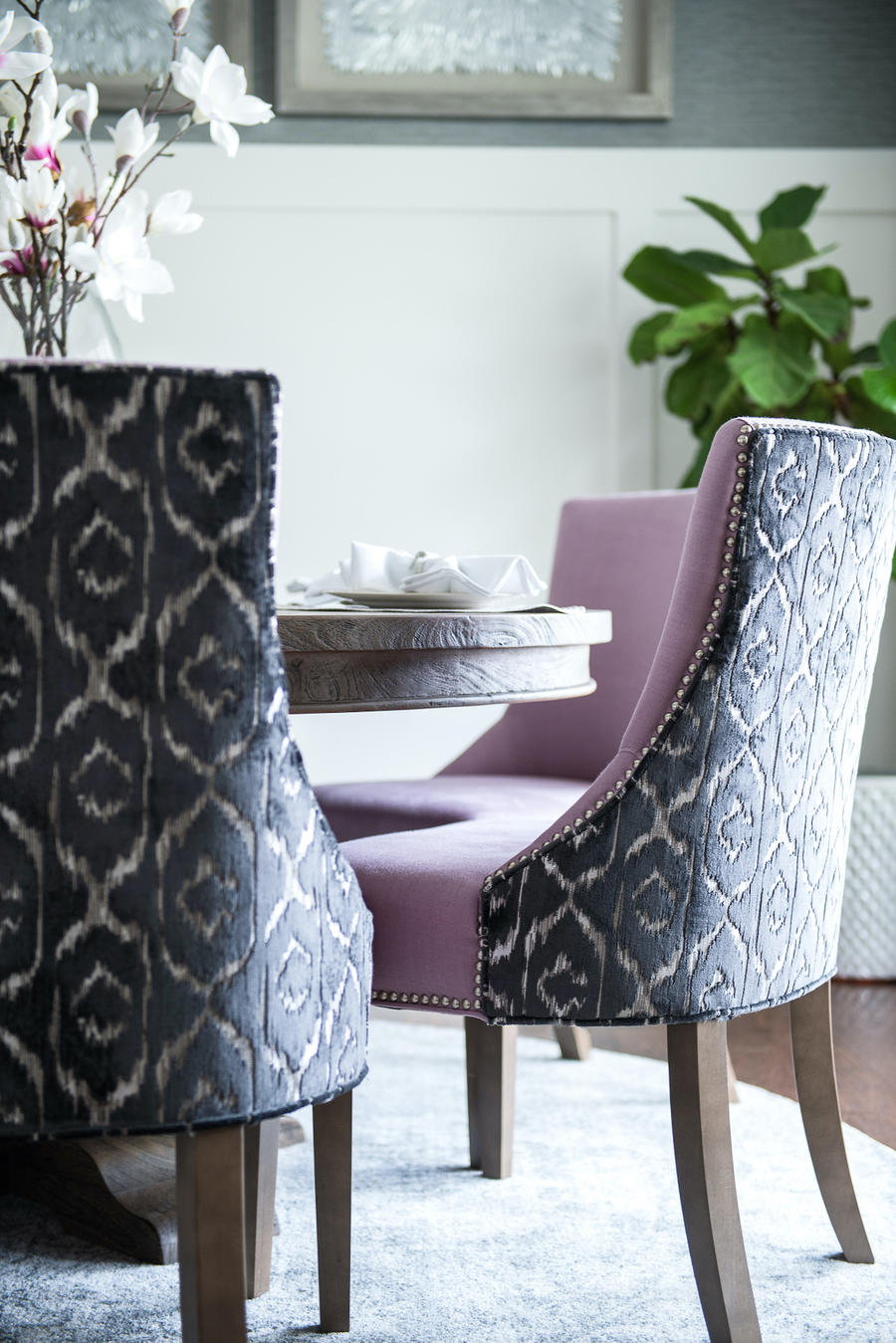

Tell me about your design presentation. What is that experience like for the client?
Once I’ve got the presentation pulled together, a canned email will go out saying it’s time to set up their design presentation, with a link to schedule that’s hooked up to my calendar availability. If they’re super busy, I can do virtual, but usually I go to their home with samples and the presentation. I print it out, but I also have it on my computer. I like to hook it up to my laptop and then screen-share it onto an iPad that they can hold, and walk them through the presentation page by page.
So the presentation always starts off with a design statement for the room, and then we go into the layout of the furniture placement. After that, we reveal the 3D rendering, and then we dive in a little deeper, showing them individual pieces of furniture. The very end is the budget.
How do you approach the billing piece?
I like to do it right away [when I first meet a client]. That way, there’s no awkwardness when it comes time to present. I don’t know what it is with this industry—I don’t know if it’s because it’s a hugely female-run industry, or if the male designers have the same problem, but talking about the numbers can be really scary and nobody wants to do it.
In the initial intake form, clients have to fill out their budget, but then when I’m talking to them over the phone, I always say, “I see your budget is this—is that number flexible at all?” Sometimes that’s a tricky thing to get around. I have a couple different PDFs displaying a living room, dining room, master bedroom and office I’ve done that are at budget-friendly prices, midrange and luxury for that type of room. Underneath is a list of the items that would go into that room, with estimated costs for that type of budget. When I send that to them, they can easily be like, “I guess these numbers do add up, when I think about it.” Then they can move forward from there.
Once we reach the point of reviewing the client homework, that’s when I’ll reapproach budget: “So, initially you said this was your budget. In your client homework, you said you want to be midrange, so now we’re looking at this type of cost. Does that still feel comfortable for you?” And then when I’m doing the presentation, there’s always that fine balance between giving the client what they want versus reality. Sometimes I push it just a little bit—where the budget might be over slightly, but I have some kind of backup in mind if they’re like, “No way, I’m not spending that.”
On a specific piece or on the room as a whole?
The specific pieces. I’m not going to do two different design presentations. But if, for example, I found an amazing rug, but it costs $10,000—and maybe that puts the budget over by $2,000, I’ll show it, but I’ll have a secondary rug picked out that will bring the budget back down [and] they’ll still get a similar look.
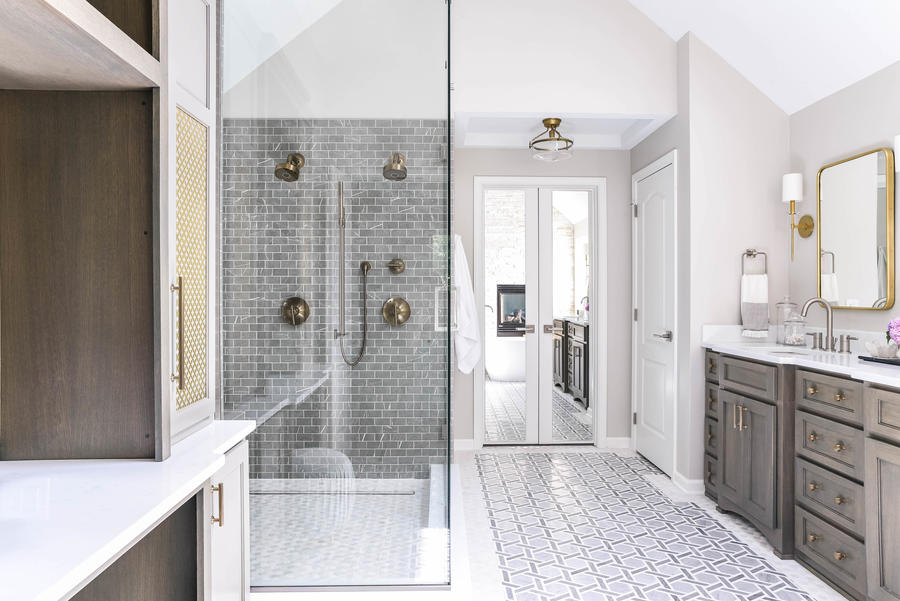
How do you bill for your services, and how do you talk about it with clients?
I bill up front for everything. I don’t do any design until I’ve gotten paid. It depends on the kind of projects, but for room transformations, I collect a flat fee for the concept per room, priced out like the size of the space. That gets them to the point of onboarding as a client, us drafting the design and putting together a presentation. Once we’ve presented, they have three free changes—or rather, three included changes, I should say. They’re not free; they’re included in the flat fee. Beyond that, it says in my contract that if you have more than three changes, it’ll be billed at an hourly rate. I’ve found that usually I don’t have more than three changes since that’s in there.
Are you charging the markup on the furniture as well?
Yes, marked up no more than retail. I want to be fair and I don’t want to gouge them, so if they were to go to a local furniture store and find the same kind of item, I’m usually trying to hit a similar price point. I also try to be upfront about that in my contract so that they know, “Hey, this benefits me, but it also benefits you.” Because in most cases, I can get you under that price. Usually. So there’s that component, but there’s also an hourly rate to procure and install.
Our team has been talking a lot about the role renderings have in the design process. When did you start including renderings in your presentation, and what impact has that had?
I’ve always tried to do some form of rendering. When I started, it was just images of single pieces of furniture that I would pull together in InDesign, where I’d try to map it out similarly on the page.
So it’d be kind of like a 2D collage that loosely looked like the furniture plan?
Basically. That’s how it started. I thought that was important to see how groupings come together. But as things evolved, [I realized] they needed a bit more of a holistic vision of how this is going to look. I took a Photoshop boot camp and tried to pull the room together myself, but it was really time-consuming and I decided there were better ways to use my time, so I started outsourcing it. I would just pull the information together, give a description of what I’m looking for, send it off to my rendering guy, and then he would put it together. There’s a fee involved in that, but it’s accounted for in our design fee. He usually gets back to me within three days, and it looks amazing, and clients see it, love it and don’t question it.
I was going to say, is it about helping them fall in love?
For sure. Because they see the 2D plan of furniture—how the furniture’s going to fit in the space—and then you turn the page and you’re like, “This is the vision of how the pieces will look in the space.” And they’re like, “Oh, my God, it’s so beautiful!”
Does that change the conversation?
It just seems like they trust me more and there are less questions. I mean, there might be a question like, “What does that upholstery piece feel like?” At that point, we can set up a time to go to the showroom to sit on the piece if it’s in town. But usually they just sit there and stare at it. I’ll explain why we selected what we did, my vision, why we put this texture in here—all the stuff that tells the story of the room. But they usually just sort of sit there and don’t say much, and then they’re like, “Great! I love it!”
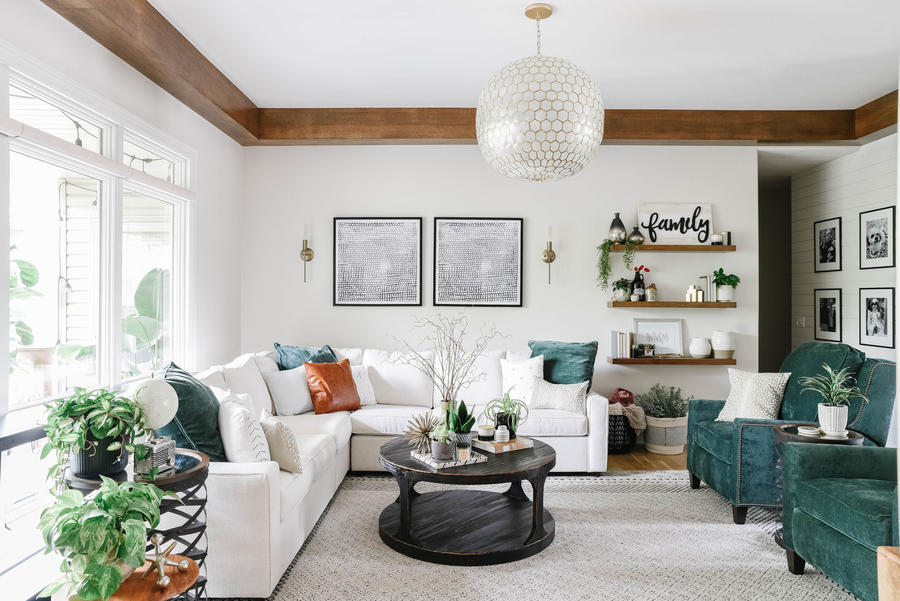
That’s amazing. Rolling the clock back a little bit, did you always know you wanted to go into design?
I always loved it. But you know, life’s just interesting. I had a serious boyfriend who I’m now married to—we’re high school sweethearts, we’ve been together for 13 years. He went to school close by, and I didn’t want to leave him to go to a faraway design school, so I ended up at the University of Nebraska Omaha to get my PR and advertising degree.
On top of that, they make you take these standardized [aptitude] tests in high school to see what you’d be good at, and mine said I wouldn’t be good at interior design.
Oh, no!
I think it was because I was such a timid high schooler. I was very introverted, still building that confidence level that I’ve grown into a lot more today. So I didn’t really pursue it. But going to UNO for my PR and advertising degree—I’m really glad I have it, and I think it’s helped me with my business a lot. Halfway through college, I met a girl at UNO who was also taking classes at a community college for interior design. She inspired me to pursue that avenue as well, so I was going to UNO and to the community college, pursuing both degrees at the same time.
I ended up interning and then working for a local designer for about a year and a half. Then I worked for a contractor, doing some of his spec work and personal assistant–type office work, which was great background information for running a business—and seeing it from the contractor’s side of view too. But going into it, he always knew I would leave to start my own business and was super supportive of that. So I worked for him for two years, from 2012 to 2014, and mostly part-time by 2014. I also established my business in 2012, but it was more part-time, trying to figure it out. And then, once I felt comfortable, I went full-time on my own.
Was there a turning point in the business where you finally felt like you hit your stride?
I would say within the last year and a half.
What brought that about?
I think it’s just all the hard work that I’ve put in over time, setting up all the systems and mapping out my website in a really clear way. And then, of course, momentum—I feel like I’ve been getting a lot more leads, and qualified leads.
That’s great. You mentioned that you have a design assistant who’s a student, but what has your team looked like over time?
I have struggled with finding the right fit and figuring out how to do it. I have bounced back and forth, like, “Do I do a W-2? Do I do a 1099-type assistant?” I’ve done both. I think W-2 is a little bit more scary to commit to, but I think it’s definitely the way to go if you want to grow your business in a professional way.
Initially, I started with an assistant that wasn’t [a] W-2 [employee]. She worked for me for two days and then found a different job. Then I ended up with a 1099 [independent contractor] assistant who worked for me for about a year and a half part-time, around the time I had my baby in 2017. She went to get her real estate license and I was without an assistant for a little over a year. I knew it would be so worth it if I would just bite the bullet and find another one instead of trying to do all these things on my own. So then, this spring, I was having lunch with another designer in town and we were like, “I need an assistant, you need an assistant, we don’t want to commit to a full-time person individually—would you be interested in sharing an assistant?” So we tried that, and it worked OK. I hired this person as a W-2, and I believe she did too, but then COVID hit and just totally derailed things.
Also, I’m having a baby—like, August 3rd is my due date.
Congratulations!
Thanks! So I realized I needed some help this summer to move projects along, and that’s when [Keleigh Ketelhut], our student rep to the board [for the Nebraska/Iowa chapter of] ASID, sent an email saying, “Hey, my internship let me go due to COVID, does anyone need help over the summer?” And I’m like, “Me. I need help! I’ll hire you this summer!” So it worked out perfectly. She’s a W-2 right now, and currently I am looking to hire a full-time designer starting in September when I’m off maternity leave, since I’m already booked up until February.
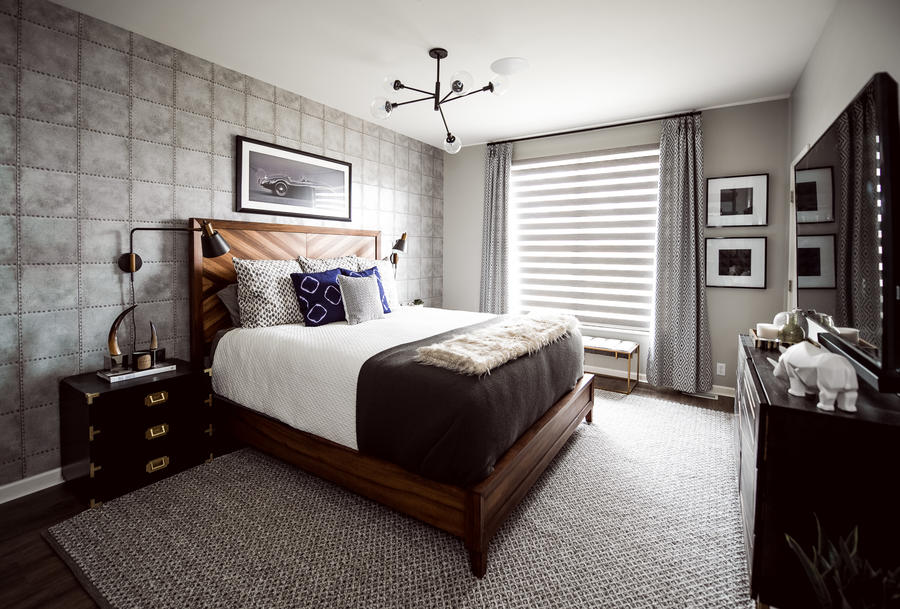
What are you looking for in a new hire?
The most important thing is someone who can self-start and take these systems that I’ve created, look at the information, and run with it. I don’t have a whole lot of time to train them—I know that’s important, but I want them to have experience in the field and a general idea of how to run these types of projects, how to utilize programs like Photoshop, InDesign, SketchUp and CAD. Also, I have a home studio, so someone who’s flexible—who’s OK with that as I’m growing and developing the business. I don’t know if I’ll ever end up with a [street-facing] space—my studio’s very secluded from the rest of my house, so it seems like a lot of overhead for an unnecessary reason, and my clients have always been OK coming here.
What does the local design community look like?
In Omaha, we’re kind of saturated with designers. I think that there are a lot of designers around here who are like, “Yeah, we’re competition, but there’s plenty [of work] to go around and we don’t feel threatened by each other.” A lot of us are friends, and a lot of us are in ASID together—right now I’m the president of the ASID chapter. But you know, then there are others who might have a different perspective and feel a little more guarded. I’ve found, over time, that the more open you are to sharing with other designers, it only elevates the profession more to the general public. So I’ve always been really receptive to it.
Are you shopping local resources mostly?
I usually source online through vendors. So, I’m not really picking things up locally, with the exception of upholstery sometimes, which is super important to clients to sit in, so I’ll try to pick something out locally. It’s definitely a mix of both, but I prefer to source from online vendors.
If I need a budget piece, I’ll source things from stores like Crate & Barrel, but I’m mostly looking at vendors like Brownstone, Bernhardt, Lexington. But having a robust website is huge, because I am not going to sit there and go through a magazine or a catalog. I go to the website and look, then move on if I don’t find what I’m looking for.
Do those vendors have some kind of local representation where your clients can go sit in it?
If it is important to them, I’m going to source from somewhere local so that I know they can go sit in it. But if I have the opportunity to buy [online from] that same vendor directly, I will, because it’s better for my business and better for my client if I can manage the overall experience more.
Where do you see the most opportunity to grow right now?
Bringing on this other designer [this fall] is probably the biggest one. I think there is lots of opportunity within these room transformation–type projects to bring someone on to run, because they can be really lucrative when we’re sourcing smartly. If someone wants to do one room or five rooms, it’s easy to calculate a profit on that [either way].
When you talk about a designer coming on to run the project, is that executing on your vision?
Eventually I would love for them to implement their own point of view, but initially it will be my vision. I’m hoping that over time, they will get accustomed to what my clients are coming to me for and have a similar point of view. That said, I don’t have one specific style, though I definitely tend to lean more toward that modern, sleek look that I guess you don’t always see in Omaha.
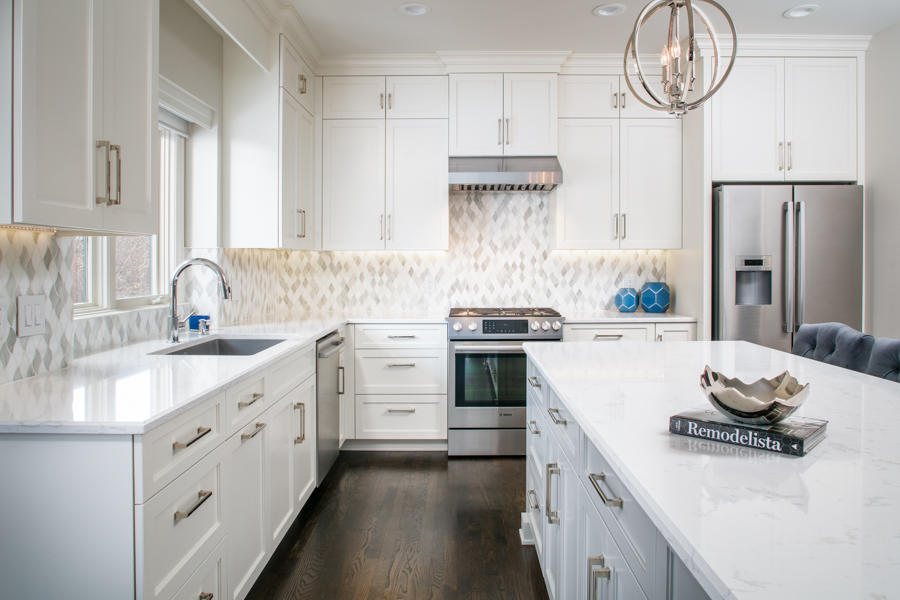
What is the biggest challenge for you right now?
Managing everything. It’s hard to be an entrepreneur. I’ve been really cheap up to now, trying to do it all on my own. I’m at the point where I’m like, You know what, I need to focus on my design work—that’s why clients are coming to me. They’re not coming to me [for] bookkeeping. So I’ve recently started outsourcing more things like that.
Are there other things you’re looking forward to handing off?
Putting together presentations. That’s something that my design assistant will start off doing. Once they are promoted to designer, I’ll probably look for another design assistant that can help both of us do those things. I also enjoy posting and interacting on social media, but I’ve found that I’m sitting in my bed at 11 p.m. watching a show with my husband while scheduling Instagram posts, and I’m like, “This sucks. I just want to go to bed.” So that’s something that I would potentially outsource too.
Is there anything you don’t want to give up?
I think I’ll always have a role in developing my website. I created my own website, and it’s helped me visualize where I want to take my business and map out my services.
One of the things I love about your site is that it feels like such a clear mission statement of who you are and how you work.
It’s been a labor of love since 2012, and it’s changed a lot over time. I get a lot of compliments on my website from clients—they love how clear each service is. A lot of design websites, locally or not, you’ll go to them and it’s just like a bullet point list: “These are the services that we offer.” And it’s like, what is that? Clients don’t know. And it might mean something totally different to me as a designer than to another designer. A selection package—like, what are the deliverables? And I think it’s important for clients to see that and the price point attached to that. Not everything I do is for a flat fee—a lot is not—but I list ranges of what they can expect if it’s a retainer-type service. It’s super important to me to have that all outlined on my website so people can clearly see it, and I think it eliminates a lot of dead-end leads. It’s all right there.

You also have a mentorship section on your site. Can you tell me about that?
I’m not sure where [that service is] going to go, to be honest, but I probably should charge more for the fee. I think it has potential to be an alternative revenue stream—something I could take online eventually. I created it because I kept finding that there are a lot of young designers who want to meet with me who are just coming out of school or want to start their own design business. I was getting a lot of requests, so I’d spend an hour and a half doing that—and I’m very glad to give back, because I did the same thing, but I’ve just found that I don’t have as much time for it.
So I just decided to do a bulk mentorship session. It’s two hours, and I limited it to 10 spots because I want it to be personal. I craft the session around common questions from people reaching out to me—they always want to know how I got to where I am; what the journey was like; things I did along the way; different avenues you can take in interior design; [advice] on business and systems; things I’ve learned and situations I’ve been in that have helped me grow.
What’s the biggest piece of advice that you would give to a young person starting a firm?
Do your research and understand how much work it is before you jump in. I struggle with that, because I think there’s something to being either young in general or young in business and just being really excited and naive about how much work it actually is. I think it’s a blessing to be naive to that and be excited about it. But I also think it’s important to know that it is a lot of work, and it’s not just sitting here picking out paint colors and meeting with clients.
Would you be where you are right now if you hadn’t worked for those other firms early early on and seen how they got the work done?
I think that’s a really important part of running a business. I recommend to someone interested in running their own business to work for an established firm [first]. The firm I worked for, she was a solo entrepreneur, so it was a much looser approach to things. Honestly, I feel like I’ve never actually had a true firm experience, so I don’t even know what that looks like. I’ve always worked for small entrepreneurs who didn’t have systems set up, so I have no idea what other firms do beyond what I hear in podcasts and talking with other designers in person.
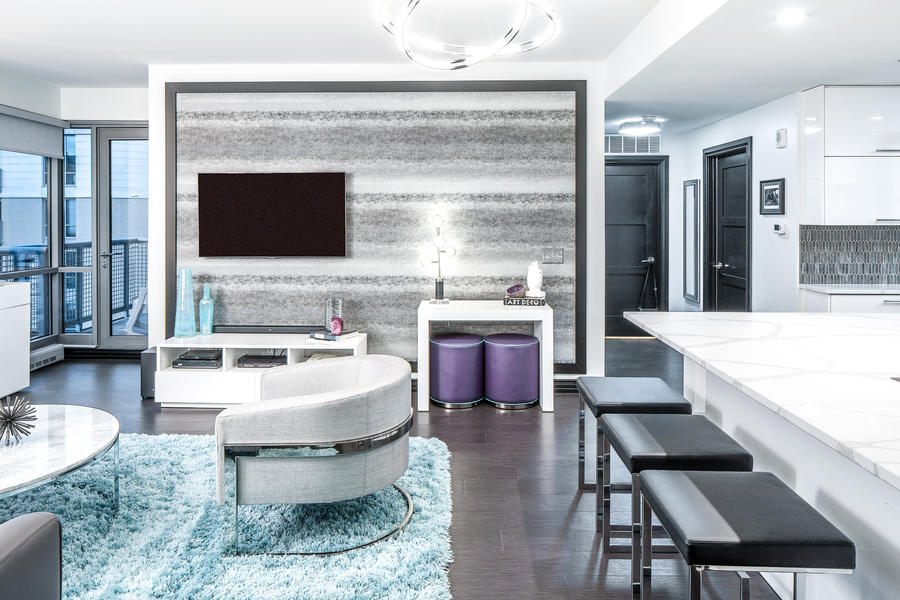
What is your relationship with your clients like?
I am really strict. I hope it doesn’t come off too rigid, but I do not allow them to text or Facebook me. It’s in my contract that our office hours are 9 a.m. to 5 p.m., and you can reach me via phone call, email or in person. I tell them that if we’re meeting at the furniture store and you’re up front and don’t know where I’m at, feel free to text me, “Hey, I’m up front.”
But project-related communication needs to happen predominantly through email—it’s just a better way to refer back to something if we need to. Plus, I don’t want to get a million photos texted to me at 7 p.m. when I’m trying to put my daughter to bed. Basically, my approach is: That’s not what you’re hiring me to do. What you’re hiring me to do is create a holistic vision for you, not [put things] together piecemeal that you’re finding on your own. Why would you hire someone for that?
Is that a rude awakening for some people?
I think because of the way I’ve set up my website, if clients are doing their due diligence beforehand, it’s an expectation, not some big question.
I will say, setting those expectations within my contract has been a process. Initially, it was very intimidating to communicate these things to my clients. I am an avid follower of Kimberley Seldon—she’s like a mentor to me, though she doesn’t know I follow her. She would say, “You need to sit down and read your contracts with your clients,” so I try to do that most of the time. I don’t always, depending on the vibe with the client, but when I was doing that initially, I would literally—I didn’t have an actual business coach at the time, but I would blame my business coach. Like, “I’m so sorry I have to sit down and read this with you, but my business coach said I have to.” And most of the clients were like, “OK.”
Are those kinds of things a result of trial and error, or because you were seeking out people like Kimberley?
It’s a combination of both. A lot of what’s in my contract is lessons learned over time where I’m like, “Nope, not doing that again!” or “That was a tricky situation to work through.” But over the past couple of years, I’ve also really gotten into podcasts—I listen to a different design business podcast every morning while getting ready, and a lot of the topics have inspired me to put things in my contract as well.
Do you still read your contracts with your clients?
It depends on the client. If I feel like they need it, I will. I use Dubsado now to send my contracts virtually, so after they sign and after our initial meetings and the client homework, I go over some bullet points, like, “I just want to make sure you saw this in the contract and don’t have any questions.”
I think there’s so much value in having that in place so you can fly from there.
Oh, my gosh, yes. It’s huge. You don’t want your business to run you, at the end of the day. You want to run your business.
To learn more about Courtney Otte, visit her website or find her on Instagram.
















